Mark Morris has a wonderful sense of timing and rhythm, he’s humorous, witty and graceful, utterly professional, precise and decisive – and that is just on the phone. Israeli audiences will have the opportunity to see the Mark Morris Dance Group in two different programs at the Israeli Opera in Tel Aviv from December 29 – January 3. Midnight East spoke with the multi-talented Mark Morris about his artistic perspective and process in anticipation of his company’s performances in Israel.
Mark Morris needs no introduction in the dance world, and his intense involvement with music – all dances are performed with live music – makes this choreographer’s work a natural crossover for concert-goers who might otherwise eschew dance.
A recipient of the Scripps Award for lifetime achievement in 2007, Morris began his career as a dancer, working with Laura Dean, Elliot Feld, Hannah Kahn, Lar Lubovitch and the Koleda Balkan Dance Ensemble. Mark Morris formed his own company in 1980 and from 1988 – 1991 the company resided at the Théatre Royal de la Monnaie as the national dance company of Belgium. In 1990 he founded the White Oak Dance Project together with Mikhail Baryshnikov, creating a vehicle for expression for dancers over 40. In 1991 he was selected a fellow of the MacArthur Foundation, and he is a member of the American Academy of Arts and Sciences. In 2001 the Mark Morris Dance Center was established in Brooklyn, more than a home for the dance company, it provides outreach programs for local children, as well as dance school for students of all ages. The company tours extensively, both in the US and internationally.
Ayelet Dekel: The name Mark Morris is almost synonymous with music, so I’m wondering what you’ve been listening to lately?
Mark Morris: Oh dear…well, I’m always listening to whatever I am working on next and I just finished a piece to Beethoven’s arrangements for Scottish songs that I’ve just been choreographing. I’ve been listening to some Vivaldi Operas that have been released lately that are incredibly great, and I don’t know what else…I’ve been performing, we’re performing the Nutcracker, you know, The Hard Nut, so I’ve been listening to that, God knows, for weeks, so I’m taking a little music break. Yeah, I do that.
AD: What do you do when you’re on a music break.
MM: Not listen to music
AD: Are there other art forms you enjoy?
MM: Sure I’m a human. I read a great deal, I go to concerts and opera. I live in New York that’s where you can do all that stuff – it’s fabulous.
AD: So when you’re on a music break, you go to concerts and listen to opera.
MM: It means I have nothing on, I mean I’m wearing clothes but I don’t have any music on.
AD: You are known for your commitment to using only live music, could you comment on the difference that makes?
MM: Well, we don’t do it any other so there is no way to know, I mean, I won’t…
I don’t work without music, because there’s no reason not to. We listen to the recording to hear the orchestration, if there’s choral music or vocal music. I have live music for class and for rehearsal and for every performance so there’s nothing to compare it to. We don’t do it any other way.
The whole point is that everybody’s there in the room doing it at that moment.
Recorded music is recorded music it already happened once and now it’s being played again, and I like a piece played the first time. Why would you want to reproduce something identically, that’s what movies are for.
I take my own musicians; they are all coming with me. If it’s an orchestra piece then I’ll bring my own conductor and some musicians or singers or whatever. If it’s an orchestra, we of course travel and meet when I’m there, but if its chamber music I bring all my own people.
AD: When creating a new piece do you see the whole thing in your head from the start?
MM: No, not at all Noooo….
I mean, I’ll have plotted some of it out, I mean I’ll know basically sometimes how many people or have a rough idea of what kind of thing it’s going to be. No, I do everything in studio with the dancers…I don’t … I work. Well, you know I’ve been choreographing for a long time…so I don’t decide how it’s going to turn out at all. I’ll have some notion of where I’m going but then that all changes in the studio when I get going on it.
I love that. It’s never what I think its going to be. So I don’t bother thinking what it’s going to be, because it will be different from that. So I find it. You know I do a lot of homework. I study it and think a lot, but really the dance itself is made up in the studio with the dancers who are going to perform it.
AD: Is the choreography coming from your own natural movement?
MM: No, I don’t improvise and then they copy it. I make it up on them; it’s not improvised at all. It’s me deciding what they do, and then they do it, that’s the job arrangement. Chuckle
AD: But it’s coming from your response to the music?
MM: I guess…I don’t know… I make it up. It’s not in the music until I find it. It’s not magic. I decide what to do and have people do it. I build it like any other structure, piece of art.
AD: When you’re building the dance do you sketch things out at all?
MM: No, just in order to show where something should go I might sketch something. No, I don’t do it at all. I work with the music and on it and remember a lot. You have to memorize everything anyway, so…
AD: You’ve worked a lot with visual artists; there is a beautiful backdrop to the Mozart…
MM: Howard Hodgkin
AD: At what point does the artist come into the process?
MM: Oh, it’s usually at the beginning with any designers I work with, décor, or lights, or costumes, I give those people the music as soon as I know what music I’m using and who I want to ask to design. So I give those people involved the music and they’re thinking about it before…
They’re thinking already, then when I have dance materials to show them, I’ll do that but it’s not necessarily… of course if you’re a costume designer you needs to know what they’re doing, what they can’t be hampered by. It happens at the same time I’m doing it – come in and watch if you’re going to design something. It works great.
AD: How involved are you with the art and costumes? Do you give them free reign to their imagination?
MM: Oh no, I decide everything. If I liked it, I keep it. Or we change it. It’s a collaboration. With Howard Hodgkin in the Mozart he sent me probably 7 or 8 different sketches –different drawings that he proposed would be possible for the backdrop, I chose 3 we’re doing two of those pieces in Tel Aviv, but there are three pieces on the program so I decided which ones went with what and he was fine with that because that was how he set it up so it was great and we get along very well.
AD: It looks beautiful; I can’t wait to see it.
MM: Oh yeah, it’s incredible.
AD: Are you still performing?
MM: Yeah, I was just in the Hard Nut, I perform a little bit. I’ll do more. I’m not quite done…almost.
AD: How do you decide when you are going to perform in a piece?
MM: I have to decide way in advance, so I can get it ready. But you know, The Hard Nut; I’ve been doing it for twenty years so I just go right in. Someone else runs rehearsal,
I just show up and do my job the same as I do otherwise. I just don’t perform very much.
I’m conducting occasionally, so that’s in a sense, still show business. I conduct the orchestra occasionally for a few pieces.
AD: You’ve been performing in The Hard Nut for twenty years, is that a sentimental choice, a tradition?
MM: No, I’m really good at it. I like it, they need me. And it’s fun. I’m not a very sentimental guy, I’ll tell you.
AD: What part do you dance?
MM: I’m the drunk party guest, as I always have been.
AD: Drunk party guest… if you do it next year I’ll come out to New York.
MM: We’re doing it in NY next year in fact. We did it in Berkeley California this year.
Next year its going to be at the Brooklyn Academy of Music so that will be great. You should come and see it.
AD: What’s next on your agenda? You mentioned Beethoven.
MM: I’m going to Edinburgh in a couple of days, that’s where it will premiere New Year’s Eve. But I won’t be there I’ll be in Israel by then I’m just going to rehearse it and then they’ll be on their own.
AD: You’ve been to Israel before, are you planning to take some time out of the studio to do things here?
MM: I don’t know yet. I was there [Israel] about twenty years ago, so I’ve been a couple of times. I have friends and we’re working all the time, I like the restaurants. I’m not a big tourist and I have no religious interests so I don’t see I don’t go to the any of the holy sites, its not interesting to me.
AD: Your dance company is composed of older dancers.
MM: Most people are in their late twenties, most people are in their thirties I would say.
AD: What are the advantages of working with older dancers?
MM: Oh, they’re better, that’s all.
AD: What makes them better?
MM: They’re smarter, they dance better and they get along with other people better.
They have lives. I don’t want to tour with a bunch of teenagers, that’s not interesting. They’re not interesting to talk to. I mean, not for more than 5 minutes.
All these people are wonderful adult dancers. That’s who I want to work with –
its not instead of something else. It’s not like – why do I have an old company? I just have a company. The ballet industry is a whole other point of view that I’m not interested in really.
You know 30 year olds and you know 18 year olds, who would you rather work with? That’s the same as me. I’m not a parent.
AD: What do you have to say to audiences who are looking for a particular dancer body with capabilities that older dancers cannot deliver?
MM: Well then, stay home.
I have in no interest in this politically; I’m not trying to teach anybody a lesson.
I work with the people I work with. I started the White Oak Dance Project and the point of that was to have people who were near the end of their regular dance career people who were 40s or something…
I have dancers in their 40s who dance with me, and in their 30s and in their 20s and it’s not to prove a point, it’s not to teach anybody a lesson, it’s the people I work with, that’s it. I have nothing to defend on that.
Here – Watch my work, here’s who’s doing it.
I’m not translating it from any other language it’s directly in its own language.
The Mark Morris Dance Group will perform at the Israeli Opera on 19 Shaul Hamelech Blvd. Tel Aviv with two programs:
Program A: December 29 & 31, January 2 at 21:00
Visitation
Music: Beethoven – Sonata for cello and piano No. 4, Op. 102, No. 1
All Fours
Music: Bartok – String Quartet No. 4
V
Music: Schumann – Piano Quintet in E Flat Major, Op. 44
Program B: December 30, January 3 at 21:00, January 1 at 13:00
Double
Music: Mozart – piano concerto No. 11, arrangement for piano and strings
Eleven
Music: Mozart – Sonata in D Major for two pianos K. 488
Grand Duo
Music: Lou Harisson – Grand Duo for violin, piano and strings, Op. 44
Tickets: 03-6927777, kupa@tapac.org.il, www.israel-opera.co.il
Image credit: from Mozart Dances/Photo: Stephanie Berger

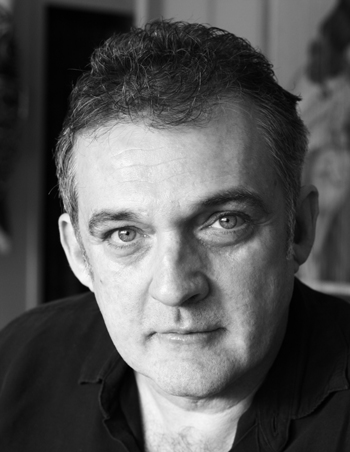
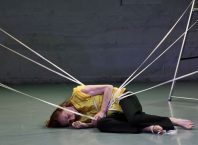
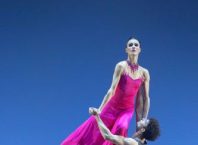
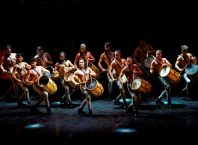

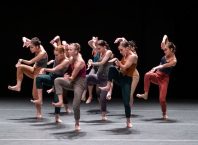
Last night’s performance of the Mark Morris ensemble was simply enthralling. As someone who enjoys classical music but shies away from dance, I can only say that I had a life-changing experience when I witnessed Mark’s interpretation of Beethoven, Bartok, and Schumann. Being familiar with the the first and last works added a special edge to the encounter like when watching a superb conductor take a beloved work into new territory. It brought tears to my eyes which hampered my binocular vision (used only on solo movements or close duets). But the most amazing work was the Bartok because I have never really enjoyed the genre until now where I felt like a double virgin witnessing such ultimate creativity of almost abstract perfectly matched music, movement, design, and symmetry. Words cannot even closely convey or express the what happened. Wish I could see the Mozart rendition tonight. Anyone got a spare ticket?
Comments are closed.